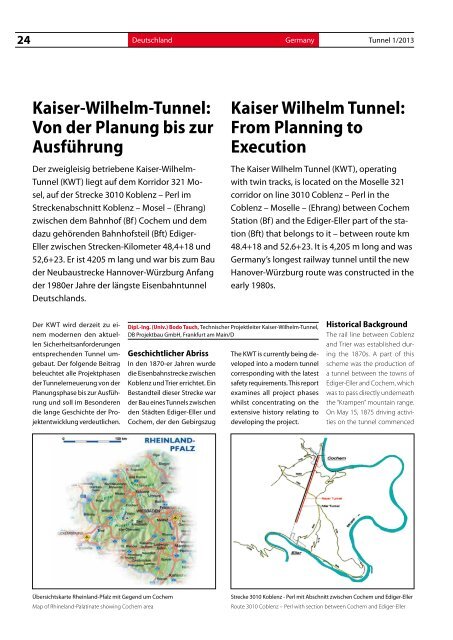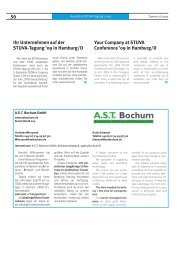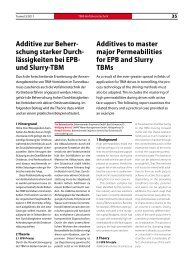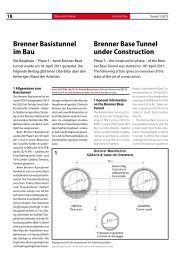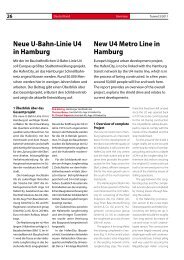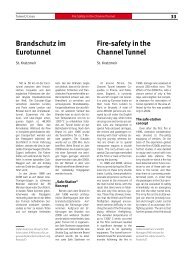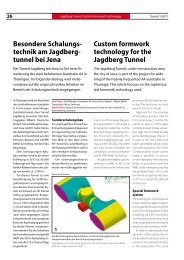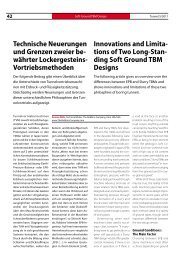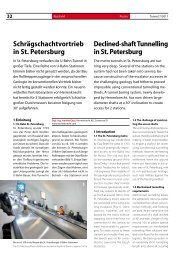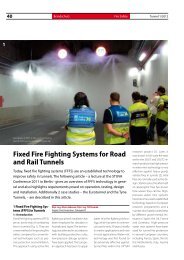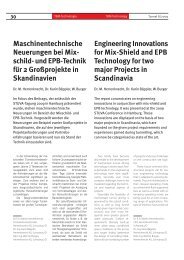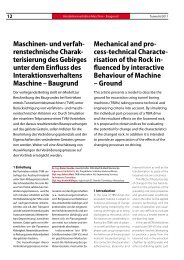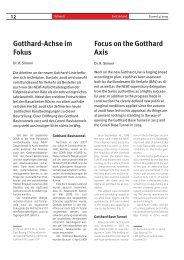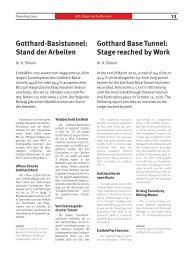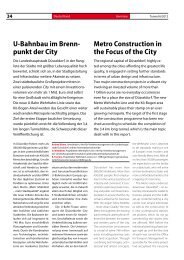Kaiser-Wilhelm-Tunnel: Von der Planung bis zur Ausführung Kaiser ...
Kaiser-Wilhelm-Tunnel: Von der Planung bis zur Ausführung Kaiser ...
Kaiser-Wilhelm-Tunnel: Von der Planung bis zur Ausführung Kaiser ...
Erfolgreiche ePaper selbst erstellen
Machen Sie aus Ihren PDF Publikationen ein blätterbares Flipbook mit unserer einzigartigen Google optimierten e-Paper Software.
24 Deutschland<br />
Germany<br />
<strong>Tunnel</strong> 1/2013<br />
<strong>Kaiser</strong>-<strong>Wilhelm</strong>-<strong>Tunnel</strong>:<br />
<strong>Von</strong> <strong>der</strong> <strong>Planung</strong> <strong>bis</strong> <strong>zur</strong><br />
Ausführung<br />
Der zweigleisig betriebene <strong>Kaiser</strong>-<strong>Wilhelm</strong>-<br />
<strong>Tunnel</strong> (KWT) liegt auf dem Korridor 321 Mosel,<br />
auf <strong>der</strong> Strecke 3010 Koblenz – Perl im<br />
Streckenabschnitt Koblenz – Mosel – (Ehrang)<br />
zwischen dem Bahnhof (Bf) Cochem und dem<br />
dazu gehörenden Bahnhofsteil (Bft) Ediger-<br />
Eller zwischen Strecken-Kilometer 48,4+18 und<br />
52,6+23. Er ist 4205 m lang und war <strong>bis</strong> zum Bau<br />
<strong>der</strong> Neubaustrecke Hannover-Würzburg Anfang<br />
<strong>der</strong> 1980er Jahre <strong>der</strong> längste Eisenbahntunnel<br />
Deutschlands.<br />
<strong>Kaiser</strong> <strong>Wilhelm</strong> <strong>Tunnel</strong>:<br />
From Planning to<br />
Execution<br />
The <strong>Kaiser</strong> <strong>Wilhelm</strong> <strong>Tunnel</strong> (KWT), operating<br />
with twin tracks, is located on the Moselle 321<br />
corridor on line 3010 Coblenz – Perl in the<br />
Coblenz – Moselle – (Ehrang) between Cochem<br />
Station (Bf) and the Ediger-Eller part of the station<br />
(Bft) that belongs to it – between route km<br />
48.4+18 and 52.6+23. It is 4,205 m long and was<br />
Germany’s longest railway tunnel until the new<br />
Hanover-Würzburg route was constructed in the<br />
early 1980s.<br />
Der KWT wird <strong>der</strong>zeit zu einem<br />
mo<strong>der</strong>nen den aktuellen<br />
Sicherheitsanfor<strong>der</strong>ungen<br />
entsprechenden <strong>Tunnel</strong> umgebaut.<br />
Der folgende Beitrag<br />
beleuchtet alle Projektphasen<br />
<strong>der</strong> <strong>Tunnel</strong>erneuerung von <strong>der</strong><br />
<strong>Planung</strong>sphase <strong>bis</strong> <strong>zur</strong> Ausführung<br />
und soll im Beson<strong>der</strong>en<br />
die lange Geschichte <strong>der</strong> Projektentwicklung<br />
verdeutlichen.<br />
Dipl.-Ing. (Univ.) Bodo Tauch, Technischer Projektleiter <strong>Kaiser</strong>-<strong>Wilhelm</strong>-<strong>Tunnel</strong>,<br />
DB Projektbau GmbH, Frankfurt am Main/D<br />
Geschichtlicher Abriss<br />
In den 1870-er Jahren wurde<br />
die Eisenbahnstrecke zwischen<br />
Koblenz und Trier errichtet. Ein<br />
Bestandteil dieser Strecke war<br />
<strong>der</strong> Bau eines <strong>Tunnel</strong>s zwischen<br />
den Städten Ediger-Eller und<br />
Cochem, <strong>der</strong> den Gebirgszug<br />
The KWT is currently being developed<br />
into a mo<strong>der</strong>n tunnel<br />
corresponding with the latest<br />
safety requirements. This report<br />
examines all project phases<br />
whilst concentrating on the<br />
extensive history relating to<br />
developing the project.<br />
Historical Background<br />
The rail line between Coblenz<br />
and Trier was established during<br />
the 1870s. A part of this<br />
scheme was the production of<br />
a tunnel between the towns of<br />
Ediger-Eller and Cochem, which<br />
was to pass directly un<strong>der</strong>neath<br />
the “Krampen” mountain range.<br />
On May 15, 1875 driving activities<br />
on the tunnel commenced<br />
Übersichtskarte Rheinland-Pfalz mit Gegend um Cochem<br />
Map of Rhineland-Palatinate showing Cochem area<br />
Strecke 3010 Koblenz - Perl mit Abschnitt zwischen Cochem und Ediger-Eller<br />
Route 3010 Coblenz – Perl with section between Cochem and Ediger-Eller
<strong>Tunnel</strong> 1/2013<br />
<strong>Kaiser</strong>-<strong>Wilhelm</strong>-<strong>Tunnel</strong>: <strong>Planung</strong> <strong>bis</strong> Ausführung<br />
25<br />
„Krampen“ direkt unterqueren<br />
sollte. Am 15. Mai 1875 begannen<br />
die Vortriebsarbeiten<br />
zu dem <strong>Tunnel</strong> aus Richtung<br />
Süden von Ediger-Eller aus, am<br />
10. August wurde aus Richtung<br />
Norden von Cochem aus gestartet.<br />
Die Bauweise bestand<br />
aus Sohlstollenvortrieb, Vollausbruch<br />
mit anschließen<strong>der</strong><br />
Auszimmerung und nachfolgen<strong>der</strong><br />
Ausmauerung <strong>der</strong> Innenschale<br />
mit kleinformatigem<br />
Grauwacken- und Schiefergestein.<br />
Nach nur vierjähriger<br />
Bauzeit ging <strong>der</strong> zweigleisige<br />
<strong>Kaiser</strong>-<strong>Wilhelm</strong>-<strong>Tunnel</strong> (KWT)<br />
1879 in Betrieb. Der <strong>Tunnel</strong> wird<br />
von rund 250 m Gebirge überdeckt<br />
und überwindet von Portal<br />
zu Portal einen Höhenunterschied<br />
von 14 m. Alle 15 <strong>bis</strong><br />
18 m sind Sicherheitsnischen<br />
eingebaut, <strong>der</strong> Gleisabstand<br />
beträgt 3,50 m. Die Baukosten<br />
betrugen seinerzeit 8,8 Mio.<br />
Reichsmark. Neben mehreren<br />
Instandsetzungen im Bereich<br />
des Gewölbes, <strong>der</strong> Sohle und<br />
den Nischen sei im Beson<strong>der</strong>en<br />
die Elektrifizierung <strong>der</strong> Moselstrecke<br />
im Jahr 1974 erwähnt.<br />
Im Zuge dieser Elektrifizierung<br />
wurde von 1972 <strong>bis</strong> 1974 die<br />
<strong>Tunnel</strong>sohle im Mittel 40 cm<br />
abgesenkt, um den erfor<strong>der</strong>lichen<br />
Raum für den Durchgang<br />
<strong>der</strong> Stromabnehmer zu<br />
erhalten. Die Fundamente <strong>der</strong><br />
Wi<strong>der</strong>lager wurden durch verankerte<br />
Stahlbetonschürzen<br />
gesichert.<br />
Einordnung in den Unternehmensplan<br />
Die Strecke 3010 Koblenz Hbf<br />
– Perl ist dem Fern- und Ballungsnetz<br />
zugeordnet. Nicht<br />
nur für den Personenverkehr<br />
mit <strong>der</strong> Anbindung an Koblenz<br />
und Trier ist diese Strecke von<br />
großer Bedeutung. Sie dient<br />
insbeson<strong>der</strong>e auch für den<br />
Güterverkehr als wichtigste<br />
Hauptabfuhrstrecke in Richtung<br />
Luxemburg und genießt<br />
damit einen sehr hohen Stellenwert<br />
im Streckennetz <strong>der</strong><br />
Deutschen Bahn. Derzeit fahren<br />
täglich rd. 170 Züge mit einer<br />
Durchschnittsgeschwindigkeit<br />
von 90 <strong>bis</strong> 120 km/h durch<br />
die Röhre.<br />
Allerdings gingen über 130<br />
Dienstjahre unter Volllast an<br />
<strong>der</strong> Innenschale des <strong>Kaiser</strong>-<br />
<strong>Wilhelm</strong>-<strong>Tunnel</strong>s nicht spurlos<br />
vorüber und <strong>der</strong> weitere<br />
<strong>Tunnel</strong>-Betrieb nur aufgrund<br />
<strong>der</strong> Absicherung durch den<br />
Bestandsschutz war nicht mehr<br />
länger vertretbar. Zudem konnten<br />
die an einen <strong>Tunnel</strong> von<br />
dieser Länge gestellten Sicherheitsanfor<strong>der</strong>ungen<br />
nicht mehr<br />
erfüllt werden. Um den Verkehr<br />
auf dieser Strecke aber auch in<br />
Zukunft sicher und zuverlässig<br />
durchführen zu können, ist die<br />
umfassende Erneuerung des<br />
<strong>Kaiser</strong>-<strong>Wilhelm</strong>-<strong>Tunnel</strong>s dringend<br />
geboten.<br />
Eine Erneuerung des zweigleisigen<br />
<strong>Tunnel</strong>s unter Betrieb<br />
hätte den Verkehr wesentlich<br />
beeinträchtigt und das Sicherheitsniveau<br />
keinesfalls<br />
verbessert. Es war vielmehr<br />
notwendig, in die vorhandene<br />
<strong>Tunnel</strong>struktur wesentlich<br />
einzugreifen und den Bau einer<br />
neuen eingleisigen <strong>Tunnel</strong>röhre<br />
vorzusehen sowie<br />
die Alte Röhre so zu erneuern,<br />
dass ebenfalls eine eingleisige<br />
Röhre entsteht.<br />
Damit sind die Voraussetzungen<br />
gegeben, dass die DB<br />
Netz AG auf <strong>der</strong> Grundlage<br />
<strong>der</strong> EBA Richtlinie 01/97 „Anfor<strong>der</strong>ungen<br />
des Brand- und<br />
Katastrophenschutzes an den<br />
Bau und Betrieb von Eisenbahntunneln“<br />
vom 1. Juli 1997<br />
mit den Ergänzungen <strong>bis</strong> zum<br />
1. November 2001 alle planerifrom<br />
the south from Ediger-Eller;<br />
work began from Cochem in the<br />
north on August 10. Construction<br />
was carried out by driving<br />
a base heading, full excavation<br />
followed by timbering and a masonry<br />
lining of the inner shell using<br />
small-format grauwacke and<br />
slate rock. The twin-track <strong>Kaiser</strong><br />
<strong>Wilhelm</strong> <strong>Tunnel</strong> (KWT) opened<br />
in 1979 after only 4 years of construction.<br />
The tunnel is covered<br />
by some 250 m of rock and overcomes<br />
a difference in altitude of<br />
14 m from portal to portal. Safety<br />
bays are provided every 15 to 18<br />
m, the centre distance amounts<br />
to 3.50 m. At the time, the construction<br />
costs amounted to 8.8<br />
million Reichsmark. Apart from<br />
several renovation schemes applying<br />
to the vault, the base and<br />
the recesses, electrification of the<br />
Moselle route in 1974 must be<br />
mentioned.<br />
As part of this electrification<br />
process, the tunnel floor was<br />
lowered by an average of 40 cm<br />
from 1972 till 1974 in or<strong>der</strong> to<br />
obtain the necessary height for<br />
installing the current collector.<br />
Reinforced concrete aprons were<br />
used to anchor the foundations<br />
for the abutment.<br />
Classification in the<br />
strategic Plan<br />
The route 3010 Coblenz Hbf<br />
– Perl is designed for mainline<br />
and regional traffic. It is of great<br />
significance for passenger traffic<br />
with connections to Coblenz<br />
and Trier, It also serves as a main<br />
transit line for goods traffic towards<br />
Luxembourg and is thus<br />
of enormous importance as part<br />
of the Deutsche Bahn route network.<br />
Currently around 170 trains<br />
pass through the tunnel on a<br />
daily basis at speeds averaging<br />
90 to 120 km/h.<br />
It must be said however that<br />
after more than 130 years of<br />
service at full capacity the inner<br />
shell of the <strong>Kaiser</strong> <strong>Wilhelm</strong> <strong>Tunnel</strong><br />
has not remained unscathed and<br />
continuing to operate the tunnel<br />
after only resorting to temporary<br />
modifications was no longer acceptable.<br />
Furthermore the safety<br />
requirements posed on a tunnel<br />
of this length could no longer<br />
be complied with. Thus it was<br />
imperative to completely renovate<br />
the <strong>Kaiser</strong> <strong>Wilhelm</strong> <strong>Tunnel</strong><br />
in or<strong>der</strong> to ensure that traffic on<br />
this route could flow safely and<br />
reliably in the future as well.<br />
Renovating the twin-track<br />
tunnel while still operational<br />
would have had a massive effect<br />
on traffic without improving the<br />
safety level. Instead it was necessary<br />
to consi<strong>der</strong>ably improve<br />
the existing tunnel structure and<br />
build a new single-track tunnel<br />
bore as well as renewing the<br />
existing tunnel to produce a<br />
further single-track bore.<br />
This meant that the prerequisites<br />
that the DB Netz AG had<br />
to fulfil on the basis of the EBA<br />
Guideline 01/97 “Requirements<br />
on Fire and Catastrophe Protection<br />
for the Construction and<br />
Operation of Railway <strong>Tunnel</strong>s”<br />
from July 1, 1997 with amendments<br />
up to November 1, 2001<br />
were met relating to all planning,<br />
constructional and operational<br />
general conditions. The planning<br />
phase for the tunnel could start.<br />
Pre-Planning<br />
In 2001/2002 a pre-planning<br />
phase was worked out for the<br />
scheduled construction of the<br />
new tunnel and the renovation<br />
of the existing one. Its outcome<br />
was duly confirmed by the responsible<br />
Deutsche Bahn (DB)<br />
offices and subsequently taken<br />
as the basis for further planning.<br />
During the pre-planning stage a<br />
number of variants were examined<br />
and included in the further
26 Deutschland<br />
Germany <strong>Tunnel</strong> 1/2013<br />
<strong>Tunnel</strong>querschnitte Neuer <strong>Tunnel</strong> und erneuerter Bestandstunnel<br />
<strong>Tunnel</strong> cross-sections of New KWT and renovated existing tunnel<br />
schen, baulichen und betrieblichen<br />
Randbedingungen <strong>der</strong><br />
Richtlinie zu erfüllen hat. Die<br />
<strong>Planung</strong> des <strong>Tunnel</strong>s konnte<br />
beginnen.<br />
Vorplanung<br />
In den Jahren 2001/2002 wurde<br />
für den geplanten Bau des<br />
Neuen und die Erneuerung des<br />
Alten <strong>Tunnel</strong>s eine Vorplanung<br />
erarbeitet, <strong>der</strong>en Ergebnis von<br />
den zuständigen Stellen <strong>der</strong><br />
Deutschen Bahn (DB) bestätigt<br />
und daraufhin <strong>der</strong> weiteren <strong>Planung</strong><br />
zu Grunde gelegt wurde.<br />
Während <strong>der</strong> Vorplanung wurden<br />
vor allem in Bezug auf<br />
• die Lage des neuen <strong>Tunnel</strong>s<br />
(westlich o<strong>der</strong> östlich des bestehenden<br />
<strong>Tunnel</strong>s),<br />
• das <strong>Tunnel</strong>vortriebskonzept<br />
(mit <strong>Tunnel</strong>bohrmaschine<br />
o<strong>der</strong> im Sprengvortrieb) und<br />
• das Abraum-Verwertungskonzept<br />
(Abtransport, Ablagerung,<br />
Wie<strong>der</strong>verwertung)<br />
mehrere Varianten untersucht<br />
und in das weitere <strong>Planung</strong>sgeschehen,<br />
zunächst das Raumordnungsverfahren,<br />
eingebracht.<br />
Raumordnerische<br />
Abstimmung<br />
Gemäß § 1 Ziffer 9 <strong>der</strong> Raumordnungsverordnung<br />
soll unter<br />
an<strong>der</strong>em bei Neubau und Trassenän<strong>der</strong>ung<br />
von Schienenstrecken<br />
ein Raumordnungsverfahren<br />
durchgeführt werden, wenn<br />
sie raumbedeutsam sind und<br />
eine überörtliche Bedeutung<br />
gegeben ist. Auf dieser Grundlage<br />
hat die Struktur- und Genehmigungsdirektion<br />
Nord<br />
(SGD Nord) in Koblenz – Obere<br />
Landesplanungsbehörde Rheinland-Pfalz<br />
– im Winter 2002/2003<br />
ein Raumordnungsverfahren<br />
durchgeführt. Dabei wurden<br />
die in Betracht kommenden<br />
Varianten, <strong>der</strong> Bau einer neuen<br />
<strong>Tunnel</strong>röhre östlich als auch<br />
westlich <strong>der</strong> bestehenden Röhre<br />
einer umfassenden raumordnerischen<br />
Prüfung unterzogen.<br />
Ergebnis <strong>der</strong> raumordnerischen<br />
Gesamtabwägung war <strong>der</strong><br />
Umbau des Alten KWT und <strong>der</strong><br />
Neubau einer zweiten <strong>Tunnel</strong>röhre<br />
östlich des bestehenden<br />
Bauwerkes (Raumordnungsbeschluss<br />
vom 28. Februar 2003,<br />
Az.: 41-433-04-1).<br />
planning activities, initially the<br />
regional planning procedure,<br />
particularly with respect to:<br />
• the location of the new tunnel<br />
(to the west or east of the<br />
existing one),<br />
• the tunnel excavation concept<br />
(with tunnel boring machines<br />
or drill+blast) and<br />
• the waste disposal concept<br />
(removal, storage, recycling).<br />
Regional Planning<br />
Compliance<br />
According to § 1 Paragraph 9<br />
of the Regional Planning Act a<br />
regional planning procedure<br />
must be un<strong>der</strong>taken for the<br />
new construction and altering<br />
of routes of railways providing it<br />
is of relevance for regional planning<br />
and at supraregional level.<br />
On this basis the Struktur- und<br />
Genehmigungsdirektion Nord<br />
(SGD Nord) in Coblenz – the<br />
supreme regional planning authority<br />
in Rhineland-Palatinate<br />
– un<strong>der</strong>took a regional planning<br />
procedure in winter 2002/2003.<br />
At the time, the possible variants,<br />
the building of a new tunnel<br />
bore either to the east or to the<br />
west of the existing one, were<br />
subjected to extensive scrutiny.<br />
The outcome of the overall appraisal<br />
foresaw the redevelopment<br />
of the old KWT and the<br />
production of a new second<br />
tunnel bore to the east of the<br />
existing one (regional planning<br />
decision reached on February 28,<br />
2003, FN: 41-433-04-1).<br />
Approval Planning<br />
Based on the regional planning<br />
ruling the documents were compiled<br />
for the approval planning<br />
and ultimately passed on to the<br />
Eisenbahn-Bundesamt (EBA) on<br />
December 8, 2003.<br />
According to § 18 of the “General<br />
Railway Act” (AEG) new rail<br />
routes or railways can only be<br />
built, existing rail installations<br />
only changed, providing that<br />
the plan has been previously<br />
approved. The purpose of the<br />
plan approval proceedings is<br />
to ensure that all public-legal<br />
relationships between the project<br />
principle (DB Netz AG) and<br />
affected persons relating to the<br />
project are coordinated, regulated<br />
appropriately by law and
<strong>Tunnel</strong> 1/2013<br />
<strong>Kaiser</strong> <strong>Wilhelm</strong> <strong>Tunnel</strong>: Planning to Execution<br />
27<br />
Genehmigungsplanung<br />
Auf <strong>der</strong> Grundlage des Raumordnungsbeschlusses<br />
wurden<br />
die Unterlagen <strong>der</strong> Genehmigungsplanung<br />
erstellt und<br />
schließlich am 8. Dezember<br />
2003 <strong>zur</strong> Planfeststellung beim<br />
Eisenbahn-Bundesamt (EBA)<br />
eingereicht.<br />
Nach § 18 des „Allgemeinen<br />
Eisenbahngesetzes“ (AEG)<br />
dürfen Schienenwege o<strong>der</strong> Eisenbahnen<br />
nur neu gebaut,<br />
bestehende Bahnanlagen nur<br />
verän<strong>der</strong>t werden, wenn <strong>der</strong><br />
Plan zuvor festgestellt worden<br />
ist. Zweck des Planfeststellungsverfahrens<br />
ist es, alle<br />
durch das Vorhaben berührten<br />
öffentlich-rechtlichen Beziehungen<br />
zwischen dem Vorhabensträger<br />
(DB Netz AG) und<br />
den Betroffenen abzustimmen,<br />
rechtsgestaltend zu regeln und<br />
den Bestand <strong>der</strong> Bahnanlagen<br />
öffentlich-rechtlich zu sichern.<br />
Die Erkenntnisse des vorangegangenen<br />
Raumordnungsverfahrens<br />
finden dabei Berücksichtigung.<br />
Die Planfeststellung erstreckt<br />
sich auf die zu bauenden<br />
o<strong>der</strong> zu än<strong>der</strong>nden Bahnanlagen,<br />
sowie auf Flächen<br />
und Anlagen Dritter, <strong>der</strong>en<br />
endgültige o<strong>der</strong> vorübergehende<br />
Inanspruchnahme<br />
(z.B. Erdablagerung, bauliche<br />
Anpassung, usw.) bei Durchführung<br />
des Vorhabens erfor<strong>der</strong>lich<br />
ist.<br />
Die Planfeststellung umfasst<br />
gemäß § 18 (1) AEG, in<br />
Fortführung <strong>der</strong> im Rahmen<br />
des Raumordnungsverfahrens<br />
durchgeführten Umweltverträglichkeitsuntersuchung,<br />
die<br />
Darstellung <strong>der</strong> Auswirkungen<br />
the rail installations secured on<br />
a public-legal basis. The recognitions<br />
resulting from the prior<br />
regional planning procedure are<br />
taken into consi<strong>der</strong>ation.<br />
The plan approval governs<br />
rail installations, which have to<br />
be built or altered as well as<br />
areas and facilities belonging<br />
to third parties, whose final or<br />
temporary utilisation (e.g. earth<br />
deposits, structural changes, etc.)<br />
is necessitated by the project.<br />
According to § 18 (1) of the<br />
General Railway Law (AEG), plan<br />
approval embraces the environmental<br />
compatibility study carried<br />
out within the scope of the<br />
regional planning procedure, the<br />
presentation of the effects of the<br />
project on the environment and<br />
compensatory and alternative<br />
measures for unavoidable ecological<br />
effects caused by the<br />
project in individual cases in accordance<br />
with § 19 Paragraphs<br />
1 and 2 of the Fe<strong>der</strong>al Nature<br />
Conservation Act (BNatSchG).<br />
In conjunction with § 75 of<br />
the Fe<strong>der</strong>al Administrative Procedure<br />
Act (VwVfG) planning<br />
approval embraces all required<br />
public-legal permits, licenses,<br />
authorisations etc.<br />
The plan approval decision<br />
(FN: 5112-03-0307-f ) was taken<br />
by the EBA on June 30, 2006 following<br />
2 sessions, at which all<br />
those involved put forward their<br />
viewpoints. It became legal in<br />
January 2007.<br />
Design Planning<br />
In or<strong>der</strong> to lose as little time as<br />
possible the design planning<br />
was carried out by an external<br />
planning office on behalf of the<br />
DB parallel to the approval plan-<br />
Erste Arbeiten in Ediger-Eller: Entstehung <strong>der</strong> Baustraße mit Schallschutzwand <strong>zur</strong> Wohnbebauung<br />
Initial work at Ediger-Eller: producing the construction road with noise abatement wall and living quarters
28 Deutschland<br />
Germany <strong>Tunnel</strong> 1/2013<br />
des Vorhabens auf die Umwelt<br />
und die Ausgleichs- und Ersatzmaßnahmen<br />
für nicht vermeidbare<br />
Umweltauswirkungen des<br />
Vorhabens im Einzelfall gemäß<br />
§ 19 Abs. 1 und 2 Bundesnaturschutzgesetz<br />
(BNatSchG).<br />
In Verbindung mit § 75 Verwaltungsverfahrensgesetz<br />
des<br />
Bundes (VwVfG) hat die Planfeststellung<br />
Konzentrationswirkung,<br />
d.h. dass sie alle erfor<strong>der</strong>lichen<br />
öffentlich-rechtlichen<br />
Genehmigungen, Erlaubnisse,<br />
Bewilligungen u.a. umfasst.<br />
Nach 2 Erörterungsterminen,<br />
bei denen alle Betroffenen<br />
ihre Belange <strong>zur</strong> Abstimmung<br />
vortragen konnten, erfolgte<br />
dann am 30. Juni 2006 <strong>der</strong><br />
Planfeststellungsbeschluss (Az.:<br />
5112-03-0307-f) durch das EBA,<br />
<strong>der</strong> schließlich im Januar 2007<br />
rechtskräftig wurde.<br />
Entwurfsplanung<br />
Um möglichst wenig Zeit zu<br />
verlieren, wurde die Entwurfsplanung<br />
parallel <strong>zur</strong> Genehmigungsplanung<br />
von einem<br />
externen <strong>Planung</strong>sbüro für die<br />
DB erstellt. Dabei erfolgte ein<br />
Abgleich zwischen Vorplanung<br />
und Genehmigungsplanung<br />
und die Entwurfsplanung wurde<br />
letztendlich mit den Ergebnissen<br />
aus <strong>der</strong> Planfeststellung<br />
ergänzt. Die interne Prüfung<br />
und Freigabe des Entwurfsheftes<br />
war 2007 abgeschlossen.<br />
Damit waren nun alle internen<br />
und externen Voraussetzungen<br />
geschaffen, um mit dem Bau<br />
des KWT zu beginnen.<br />
Vergabeplanung<br />
Trotz dieser Voraussetzungen<br />
dauerte es noch <strong>bis</strong> Mitte 2008,<br />
bevor die ersten Arbeiten in<br />
Ediger-Eller beginnen konnten.<br />
Schließlich musste noch die<br />
Vergabe sinnvoll geplant werden,<br />
das Projekt in Bauphasen<br />
unterteilt und die Verdingungsunterlagen<br />
erstellt werden.<br />
An dieser Stelle wird die<br />
Gesamtbaumaßnahme kurz<br />
vorgestellt.<br />
Kurzbeschreibung <strong>der</strong><br />
Baumaßnahme<br />
Das Projekt „Bau des Neuen<br />
und Erneuerung des Alten<br />
<strong>Kaiser</strong>-<strong>Wilhelm</strong>-<strong>Tunnel</strong>s“ sieht<br />
folgende Maßnahmen vor:<br />
• Trennung <strong>der</strong> Richtungsgleise<br />
in 2 separate, eingleisig<br />
betriebene <strong>Tunnel</strong>röhren für<br />
<strong>Tunnel</strong>, die von Personenund<br />
Güterzügen durchfahren<br />
werden, d.h.<br />
• Bau einer neuen eingleisigen<br />
<strong>Tunnel</strong>röhre parallel zum bestehenden<br />
<strong>Tunnel</strong>,<br />
• Erstellung von 8 Verbindungsbauwerken<br />
zwischen<br />
den <strong>Tunnel</strong>röhren im Abstand<br />
von maximal 500 m,<br />
• Einbau einer neuen Innenschale<br />
in den bestehenden<br />
<strong>Kaiser</strong>-<strong>Wilhelm</strong>-<strong>Tunnel</strong>, dabei<br />
Rückbau <strong>zur</strong> eingleisigen<br />
Röhre,<br />
• Anpassung und Erweiterung<br />
<strong>der</strong> <strong>Tunnel</strong>ausrüstung mit<br />
dem Ziel <strong>der</strong> Angleichung<br />
an die Richtlinie des EBA<br />
„Anfor<strong>der</strong>ungen des Brandund<br />
Katastrophenschutzes<br />
an den Bau und den Betrieb<br />
von Eisenbahntunneln“ und<br />
die „Technischen Spezifikationen<br />
für Interoperabilität<br />
(TSI)“,<br />
• Herstellung einer neuen<br />
Drei-Feld-Brücke für das<br />
Gleis Trier-Koblenz im Stadtbereich<br />
Cochem.<br />
1. Bauphase: Bau des<br />
Neuen <strong>Kaiser</strong>-<strong>Wilhelm</strong>-<br />
<strong>Tunnel</strong> (NKWT)<br />
In <strong>der</strong> 1. Bauphase wird <strong>der</strong><br />
Alte <strong>Kaiser</strong>-<strong>Wilhelm</strong>-<strong>Tunnel</strong><br />
(AKWT) um eine zweite, parallel<br />
geführte Röhre, den Neuen<br />
Voreinschnitt Ediger-Eller von oben mit Baustelleneinrichtung für den<br />
<strong>Tunnel</strong>vortrieb NKWT<br />
Ediger-Eller pre-cut seen from above with site installation<br />
for driving the NKWT<br />
ning. Towards this end the preplanning<br />
and approval planning<br />
stages were harmonised and the<br />
design planning supplemented<br />
by planning approval results. Internal<br />
scrutiny and the go-ahead for<br />
the design report were completed<br />
in 2007. In this way all internal and<br />
external prerequisites had been<br />
created enabling work on the KWT<br />
could be embarked on.<br />
Award Planning<br />
In spite of these prior conditions<br />
the first work at Ediger-Eller only<br />
got started in mid-2008. After all<br />
awards had to be planned satisfactorily,<br />
the project divided<br />
into construction phases and the<br />
ten<strong>der</strong>ing documents compiled.<br />
Let us take avail of the opportunity<br />
to present the overall<br />
construction scheme.<br />
Short Description of the<br />
Construction Scheme<br />
The project “Building of the new<br />
<strong>Kaiser</strong> <strong>Wilhelm</strong> <strong>Tunnel</strong> and Renewal<br />
of the Old <strong>Tunnel</strong>” involves<br />
the following measures:<br />
• Separating the 2-way tracks<br />
into 2 individual, single-track<br />
operation tunnel bores, used<br />
by both passenger and goods<br />
trains, i.e.<br />
• Construction of a new singletrack<br />
tunnel bore parallel to<br />
the existing tunnel,<br />
• Production of 8 connecting<br />
structures between the tunnel<br />
bores at maximum gaps<br />
of 400 m,<br />
• Installation of a new inner shell<br />
in the existing <strong>Kaiser</strong> <strong>Wilhelm</strong><br />
<strong>Tunnel</strong>, while converting it to<br />
a single-track bore,<br />
• Adaptation and extension of<br />
the tunnel furnishings with the<br />
objective of complying with<br />
the EBA standard “Requirements<br />
on Fire and Catastrophe<br />
Protection for the Construction<br />
and Operation of Railway<br />
<strong>Tunnel</strong>s” and the “Technical<br />
Specifications for Interoperability<br />
(TSI)”,<br />
• Production of a new 3-section<br />
bridge for the Trier-Coblenz<br />
line within the town of Cochem.<br />
1 st Construction Phase:<br />
Producing the New<br />
<strong>Kaiser</strong> <strong>Wilhelm</strong> <strong>Tunnel</strong><br />
(NKWT)<br />
During the 1 st construction<br />
phase the Old <strong>Kaiser</strong> <strong>Wilhelm</strong><br />
<strong>Tunnel</strong> (AKWT) is provided<br />
with an additional second bore<br />
running parallel to it, the New
<strong>Tunnel</strong> 1/2013<br />
<strong>Kaiser</strong>-<strong>Wilhelm</strong>-<strong>Tunnel</strong>: <strong>Planung</strong> <strong>bis</strong> Ausführung<br />
29<br />
Voreinschnitt Cochem von oben: <strong>Tunnel</strong>anschlagwand Ausfahrt TVM in<br />
unmittelbarer Nähe <strong>der</strong> Wohnbebauung<br />
Cochem precut from above: tunnel start-up wall – TBM exit close to<br />
living quarters<br />
<strong>Kaiser</strong>-<strong>Wilhelm</strong>-<strong>Tunnel</strong> (NKWT)<br />
ergänzt. Diese neue Röhre wird<br />
eingleisig ausgebaut. Dabei<br />
werden die 8 Verbindungsbauwerke<br />
bereits hergestellt und<br />
zum AKWT durchgeschlagen.<br />
Parallel dazu wird die für den<br />
Betrieb des NKWT notwendige<br />
Eisenbahnüberführung (EÜ)<br />
„Brückenstraße“ am Cochemer<br />
Portal hergestellt. Sie wird als<br />
10,40 m breite Drei-Feld-Brücke<br />
mit den lichten Weiten von je<br />
10,80 m ausgebildet.<br />
Nach Fertigstellung des <strong>Tunnel</strong>rohbaus<br />
wird <strong>der</strong> NKWT <strong>bis</strong><br />
hin zu den Rettungsplätzen<br />
mit einer sogenannten befahrbaren<br />
Festen Fahrbahn<br />
versehen. Diese kann von<br />
Straßenfahrzeugen auf <strong>der</strong><br />
gesamten Länge befahren<br />
werden und ermöglicht so im<br />
Notfall eine bessere Anfahrt<br />
<strong>der</strong> Rettungsfahrzeuge. Außerhalb<br />
<strong>der</strong> Streckenabschnitte<br />
mit Fester Fahrbahn erfolgt<br />
die Herstellung des Oberbaus<br />
aus Schotter. Danach werden<br />
alle sicherheitstechnisch notwendigen<br />
Ausrüstungen unter<br />
Berücksichtigung <strong>der</strong> Vorgaben<br />
<strong>der</strong> TSI-Spezifikationen installiert.<br />
Erst nach Abnahme des<br />
NKWT gemäß diesen Vorgaben<br />
kann dann <strong>der</strong> neue <strong>Tunnel</strong> in<br />
Betrieb genommen und damit<br />
die 1. Bauphase abgeschlossen<br />
werden. Bis <strong>zur</strong> Inbetriebnahme<br />
des NKWT bleibt <strong>der</strong> AKWT<br />
weiterhin in Betrieb.<br />
<strong>Kaiser</strong> <strong>Wilhelm</strong> <strong>Tunnel</strong> (NKWT).<br />
This new bore possesses a single<br />
track. In the process, the 8 connecting<br />
structures are built and<br />
linked up with the AKWT. Parallel<br />
to this the “Brückenstraße” rail<br />
overpass (EÜ) required for operating<br />
the NKWT is produced at<br />
the Cochem portal. It takes the<br />
form of a 10.40 m wide 3-section<br />
bridge each with clear widths of<br />
10.80 m.<br />
After completion of the tunnel<br />
roughwork the NKWT is to be<br />
provided with an accessible solid<br />
slab track right up to the evacuation<br />
areas. This can be used<br />
by road vehicles over its entire<br />
length thus making it easier for<br />
emergency services to arrive on<br />
the spot should there be an incident.<br />
Outside the solid slab track<br />
section, the superstructure possesses<br />
a ballast bed. Accordingly<br />
<strong>Tunnel</strong>vortriebsmaschine bei <strong>der</strong> Andrehfeier am 10. April 2010<br />
TBM being ceremoniously started up on April 10, 2010<br />
all safety technical systems needed<br />
are installed in keeping with<br />
TSI specifications. The NKWT can<br />
first be opened once all these<br />
conditions are complied with<br />
thus bringing the 1 st construction<br />
phase to a conclusion. The<br />
AKWT will remain operational<br />
until the NKWT is opened.<br />
2 nd Construction Phase:<br />
Renovating the Old<br />
<strong>Kaiser</strong> <strong>Wilhelm</strong> <strong>Tunnel</strong><br />
(AKWT)<br />
After completing and commissioning<br />
the NKWT, the AKWT will<br />
be closed and redeveloped. The<br />
tunnel cross-section suffices to<br />
permit a new concrete bore to<br />
be installed without having to<br />
remove the existing masonry.<br />
Once the tracks, the ballast<br />
and the engineering technology<br />
have been removed, a new
30 Deutschland<br />
Germany <strong>Tunnel</strong> 1/2013<br />
<strong>Tunnel</strong>durchschlag am 7. November 2011<br />
<strong>Tunnel</strong> breakthrough on November 7, 2011<br />
2. Bauphase: Erneuerung<br />
des Alten <strong>Kaiser</strong>-<br />
<strong>Wilhelm</strong>-<strong>Tunnel</strong> (AKWT)<br />
Nach <strong>der</strong> Fertigstellung und<br />
Inbetriebnahme des NKWT<br />
wird <strong>der</strong> AKWT außer Betrieb<br />
genommen und erneuert. Der<br />
Querschnitt des <strong>Tunnel</strong>s reicht<br />
dabei aus, um eine neue Betonröhre<br />
einzuziehen und das<br />
bestehende Mauerwerk nicht<br />
<strong>zur</strong>ückbauen zu müssen. Nachdem<br />
die Gleise, <strong>der</strong> Schotter und<br />
die Ausrüstungstechnik ausgebaut<br />
sind, wird eine neue Sohle<br />
hergestellt und nachlaufend ein<br />
Gewölbe eingebaut. Der Ausbau<br />
erfolgt komplett in Ortbeton.<br />
Nach <strong>der</strong> Fertigstellung des Rohbaus<br />
werden im AKWT ebenfalls<br />
<strong>der</strong> Oberbau als befahrbare Feste<br />
Fahrbahn, die Oberleitung, die<br />
Sicherheitsausrüstung sowie die<br />
Leit- und Sicherungstechnik auf<br />
den neuesten Stand <strong>der</strong> Technik<br />
gebracht. Während dieser<br />
Bauphase werden die 8 Verbindungsbauwerke<br />
vervollständigt<br />
und ins Gesamtprojekt KWT integriert.<br />
Nach Abschluss <strong>der</strong> 2. Bauphase<br />
wird <strong>der</strong> gesamte <strong>Tunnel</strong><br />
abgenommen und ist damit an<br />
den neuesten Stand <strong>der</strong> Technik<br />
angepasst.<br />
Bauablauf und Stand<br />
<strong>der</strong> Arbeiten<br />
Das gesamte Projekt wurde in<br />
mehrere Vergabepakete (VP)<br />
unterteilt. Ziel dabei war es,<br />
Fachfirmen für die einzelnen<br />
Gewerke direkt beauftragen<br />
zu können und so den Mittelstand<br />
zu för<strong>der</strong>n. Der zeitliche<br />
Ablauf ist dabei wie in Tabelle<br />
1 dargestellt geplant.<br />
floor will be produced and then<br />
a vault installed. Supporting will<br />
be accomplished entirely with in<br />
situ concrete. After completion<br />
of the roughwork in the AKWT<br />
a solid slab track, the overhead<br />
wire, the safety equipment will all<br />
be installed to comply with the<br />
latest standard of engineering.<br />
During this construction phase<br />
the 8 connecting structures will<br />
be completed and integrated in<br />
the overall KWT project. After concluding<br />
the 2 nd construction phase<br />
Endphase Bau <strong>der</strong> Eisenbahnüberführung Brückenstraße Cochem<br />
Final phase of constructing the “Brückenstraße” rail overpass in Cochem
BAU<br />
Unternehmen<br />
des Jahres<br />
Zählt Ihr<br />
Unternehmen<br />
zu den Besten?<br />
Wir laden Sie ein:<br />
Zum ersten Mal veranstalten das Fachmagazin<br />
tHIS und <strong>der</strong> Lehrstuhl für Bauprozessmanagement<br />
und Immobilienentwicklung <strong>der</strong> TU München<br />
den Wettbewerb „Bauunternehmen des<br />
Jahres“. Unternehmen mit einer Betriebsgröße<br />
ab 25 Mitarbeitern erhalten hier die Möglichkeit,<br />
in einem unabhängigen Benchmark-<br />
Verfahren ihre Wettbewerbsstärke messen zu<br />
lassen. Jedes Unternehmen hat einen unmittelbaren<br />
Nutzen bei einer Teilnahme: Sie<br />
bekommen eine detaillierte Auswertung, die<br />
Ihnen Aufschluss über die Position Ihres<br />
Unternehmens auch im Vergleich zu an<strong>der</strong>en<br />
Unternehmen gibt.<br />
Eine Initiative und organisiert von:<br />
Wir laden Sie ganz herzlich ein, den Fragebogen<br />
unter <strong>der</strong> Webadresse www.bauunternehmendes-jahres.de/<br />
auszufüllen.<br />
Die Teilnahme am Wettbewerb ist kostenlos<br />
und Ihre Daten werden selbstverständlich vertraulich<br />
behandelt. Einsendeschluss für den<br />
Fragebogen ist <strong>der</strong> 28. Februar 2013.<br />
Nehmen Sie am Wettbewerb teil und zeigen<br />
Sie, wo Sie stehen. Wir würden uns freuen, Sie<br />
für Ihre Leistungen auf einer geson<strong>der</strong>ten Veranstaltung<br />
auszuzeichnen.
32 Deutschland<br />
Germany <strong>Tunnel</strong> 1/2013<br />
Vergabepaket Beschreibung Zeitraum<br />
1 Rodungsarbeiten 2008<br />
2 Baustelleneinrichtung und Herstellung<br />
<strong>der</strong> Baustraße<br />
2008 <strong>bis</strong> 2009<br />
3 Herstellung <strong>der</strong> neuen <strong>Tunnel</strong>röhre<br />
(NKWT)<br />
2010 <strong>bis</strong> 2011<br />
4 Errichtung <strong>der</strong> Stütz- u. Brückenbaubauwerke<br />
Cochem<br />
2010 <strong>bis</strong> 2011<br />
5 Installation <strong>der</strong> Festen Fahrbahn (NKWT) 2012<br />
6 Installation <strong>der</strong> technischen Ausrüstung<br />
(NKWT)<br />
2012 <strong>bis</strong> 2013<br />
7 Erneuerung des Bestandstunnels (AKWT) 2013 <strong>bis</strong> 2014<br />
8 Installation <strong>der</strong> Festen Fahrbahn<br />
(AKWT)<br />
2015<br />
9 Installation <strong>der</strong> technischen Ausrüstung<br />
(AKWT)<br />
2015<br />
Tabelle 1: Zeitlicher Ablauf <strong>der</strong> Baumaßnahme<br />
Contract Section Description Period<br />
1 Clearance work 2008<br />
2 Site installation and production<br />
of the construction road<br />
2008 to 2009<br />
3 Production of the new tunnel bore<br />
(NKWT)<br />
2010 to 2011<br />
4 Setting up the supporting and bridge<br />
structure Cochem<br />
2010 to 2011<br />
5 Installing the solid slab track (NKWT) 2012<br />
6 Installation of the technical equipment<br />
(NKWT)<br />
2012 to 2013<br />
7 Renewing the existing tunnel (AKWT) 2013 to 2014<br />
8 Installation of the solid slab track<br />
(AKWT)<br />
2015<br />
9 Installation of the technical<br />
Equipment (AKWT)<br />
2015<br />
Table 1: Timetable for the Construction Scheme<br />
Durch die Aufteilung in Vergabepakete<br />
gelang es <strong>bis</strong>her<br />
alle Arbeiten weitgehend im<br />
Plansoll zu erledigen. Derzeit<br />
sind die Arbeiten des VP 1 <strong>bis</strong><br />
VP 4 abgeschlossen, VP 5 hat<br />
seine Arbeiten aufgenommen,<br />
VP 6 hat ebenfalls mit<br />
den ersten Arbeiten außerhalb<br />
des NKWT begonnen.<br />
Die Ausschreibung des VP 7 ist<br />
abgeschlossen, mit den ersten<br />
Arbeiten, <strong>der</strong> Erstellung <strong>der</strong><br />
Ausführungsplanung, wird im<br />
ersten Halbjahr 2013 begonnen.<br />
Die weiteren VP 8 und VP<br />
9 werden in 2013 vorbereitet<br />
und sollen ab 2014 ausgeschrieben<br />
werden.<br />
Beson<strong>der</strong>heiten während<br />
des Bauablaufs<br />
Der Vortrieb des NKWT erfolgte<br />
vom Südportal aus in Richtung<br />
Koblenz mit Maschinenvortrieb<br />
und einschaligem Tübbing-<br />
Ausbau aus Betonfertigteilen.<br />
Beide <strong>Tunnel</strong>portale mussten<br />
durch Stützbauwerke abgesichert<br />
werden. Die <strong>Tunnel</strong>vortriebsmaschine<br />
mit einem<br />
Durchmesser von gut 10 m<br />
war dabei so konzipiert, dass<br />
sie sowohl das überwiegend<br />
anstehende Festgestein als<br />
auch eine Lockergesteinsstrecke<br />
im Bereich <strong>der</strong> Cochemer<br />
Oberstadt durchörtern konnte.<br />
Außerdem musste die Coche-<br />
the entire tunnel will be approved<br />
after ensuring it complies with the<br />
latest state of the art.<br />
Construction Cycle and<br />
Stage reached by Work<br />
The entire project is split up<br />
into several contract sections<br />
(VP). The aim was to commission<br />
specialist firms directly to<br />
un<strong>der</strong>take the various assignments<br />
thus boosting mediumsized<br />
businesses. Table 1 displays<br />
the chronology involved.<br />
As a result of the allocation<br />
of contract sections it<br />
was largely possible to adhere<br />
to the intended timetable. At<br />
present work on sections VP 1<br />
to VP 4 has been completed. VP<br />
5 is in progress and initial work<br />
has begun outside the NKWT<br />
on VP 6. The ten<strong>der</strong>ing stage<br />
for VP 7 has been concluded;<br />
the first half of 2013 will see<br />
work starting here on drawing<br />
up the execution planning. VP<br />
8 and VP 9 are to be tackled<br />
in the course of 2013 and invitations<br />
for bids requested in<br />
2014.<br />
Special Features during<br />
the Construction<br />
Process<br />
The NKWT is being driven from<br />
the south portal in the direction<br />
of Coblenz with a mechanised<br />
DBProjektBau GmbH, eigener Bestand<br />
Fertiger <strong>Tunnel</strong>rohbau NKWT mit Ausgleichsschicht vor Beginn <strong>der</strong> Arbeiten am Oberbau<br />
Completed tunnel roughwork with compensation layer prior to starting on the superstructure<br />
<strong>Tunnel</strong>ansicht NKWT innen Blick Richtung Cochem<br />
View inside the NKWT towards Cochem
<strong>Tunnel</strong> 1/2013<br />
<strong>Kaiser</strong>-<strong>Wilhelm</strong>-<strong>Tunnel</strong>: <strong>Planung</strong> <strong>bis</strong> Ausführung<br />
33<br />
mer Oberstadt mit teilweise<br />
nur 5 m Überdeckung unterfahren<br />
werden. Dies erfor<strong>der</strong>te<br />
neben <strong>der</strong> präzisen Steuerung<br />
<strong>der</strong> Maschine ein umfassendes<br />
Monitoring, bei dem alle<br />
Messwerte von entsprechenden<br />
Fachleuten permanent<br />
ausgewertet und kontrolliert<br />
wurden. Zusätzlich wurde<br />
unterhalb <strong>der</strong> beson<strong>der</strong>s gefährdeten<br />
Bereiche einiger<br />
Häuser vorlaufend <strong>der</strong> Untergrund<br />
zwischen Bohrmaschine<br />
und Fundamentunterkanten<br />
mithilfe von Bodeninjektionen<br />
stabilisiert. Damit konnten die<br />
Setzungen zusätzlich minimiert<br />
werden.<br />
Der Abtransport <strong>der</strong> über<br />
900.000 t Ausbruch erfolgte<br />
zunächst in eine Tongrube<br />
im Westerwald. Dabei war<br />
<strong>der</strong> Vortrieb direkt abhängig<br />
vom festgelegten schienengebundenen<br />
Abtransport. Über<br />
die stark befahrene Strecke<br />
konnten täglich ca. 1000 m³<br />
Ausbruchmaterial weggefahren<br />
werden, was einer durchschnittlichen<br />
Vortriebsleistung<br />
von 10 m/Tag entsprach.<br />
Um den durch unvorhergesehene<br />
Stillstände <strong>der</strong> Vortriebsmaschine<br />
entstandenen Zeitverlust<br />
wie<strong>der</strong> aufzuholen,<br />
gelang es, eine ehemalige<br />
Deponie in Wittlich mit Unterstützung<br />
<strong>der</strong> Behörden so<br />
zügig zu reaktivieren und mit<br />
Ausbruch zu versorgen, dass<br />
<strong>der</strong> Vortrieb zeitweise um ein<br />
Drittel beschleunigt werden<br />
konnte. Der Abtransport des<br />
Ausbruchs sowie <strong>der</strong> Transport<br />
<strong>der</strong> Tübbinge <strong>zur</strong> Baustelle<br />
erfolgten ausschließlich mit<br />
Zügen und reduzierten so die<br />
Lärm- und Staubemissionen<br />
erheblich.<br />
Die aufgezeigten Beson<strong>der</strong>heiten<br />
können nur einen Teil<br />
des Baugeschehens wie<strong>der</strong><br />
geben. Gerade in den Voreinschnitten<br />
muss immer wie<strong>der</strong><br />
mit unvorhergesehenen Zwischenfällen<br />
gerechnet werden,<br />
da <strong>der</strong> Bestand unterhalb <strong>der</strong><br />
Gleise nicht vollständig dokumentiert<br />
ist, aber schon häufig<br />
zu Zusatzarbeiten geführt hat,<br />
die in das Baugeschehen integriert<br />
werden müssen.<br />
Fazit<br />
Mit dem Neubau und <strong>der</strong> Erneuerung<br />
des KWT kann das<br />
Sicherheitsniveau des <strong>Tunnel</strong>s<br />
auf den heute gefor<strong>der</strong>ten aktuellen<br />
Stand gebracht werden.<br />
Allerdings vergeht vom Konzept<br />
des Neubaus Anfang 2001<br />
eine sehr lange Zeit <strong>bis</strong> <strong>zur</strong> Vollendung.<br />
Nach <strong>der</strong> 7-jährigen<br />
<strong>Planung</strong>sphase werden weitere<br />
7 Jahre Bauphase benötigt um<br />
das Gesamtprojekt abschließen<br />
und somit den KWT für<br />
die Bahnstrecke Koblenz–Perl<br />
langfristig als Bestandteil des<br />
Transeuropäischen Netzes<br />
(TEN) erhalten zu können.<br />
excavation and a single-shell<br />
support consisting of concrete<br />
precast parts. Both tunnel portals<br />
had to be secured by supporting<br />
structures. The tunnel boring<br />
machine with 10 m diameter<br />
was devised in such a way that<br />
it could pass through what was<br />
mainly hard rock as well as a<br />
soft ground section in the upper<br />
reaches of the town of Cochem<br />
with overburden of only<br />
5 m in some cases. In addition<br />
to utmost precision in steering<br />
the machine, comprehensive<br />
monitoring was required. All the<br />
measured values had to be evaluated<br />
and checked at all times<br />
by corresponding experts. Furthermore<br />
in particularly endangered<br />
areas beneath a number<br />
of houses the ground between<br />
the boring machine and the lower<br />
edge of the foundations had<br />
to be stabilised using soil grouting.<br />
In this way settlements were<br />
confined to a minimum.<br />
Initially the more than<br />
900,000 t of excavated material<br />
removed was taken to a clay<br />
quarry in the Westerwald. For<br />
this purpose the drive depended<br />
directly on the trackbound transportation<br />
process. It was possible<br />
to remove around 1,000 m³ of<br />
waste daily via the busy route,<br />
representing an average rate of<br />
advance of 10 m/day. In or<strong>der</strong> to<br />
compensate for delays caused<br />
by temporary standstills of the<br />
boring machine, it was possible<br />
to quickly reactivate a former<br />
dump at Wittlich with the help<br />
of the authorities and fill it with<br />
excavated material so that the<br />
drive could be speeded up by<br />
a third in some cases. The excavated<br />
material was removed and<br />
the segments carried to the site<br />
exclusively by means of trains,<br />
which consi<strong>der</strong>ably reduced<br />
noise and dust emissions.<br />
The special features mentioned<br />
are merely capable of reflecting<br />
a part of the construction<br />
process. In the pre-cuts in particular<br />
unforeseen incidents tended<br />
to occur as there was no complete<br />
record available of what was<br />
located beneath the tracks, which<br />
led to additional activities, which<br />
had to be integrated within the<br />
construction process.<br />
Summary<br />
Thanks to the building of a new<br />
bore and renewal of the existing<br />
KWT the tunnel’s safety level<br />
can be upgraded and enabled<br />
to comply with current required<br />
standards. It must be said however<br />
that the concept of the new<br />
structure took a long time to<br />
bear fruit after being proposed<br />
in early 2001. Following a 7-year<br />
planning phase, a further 7 years<br />
of construction will be needed<br />
to complete the overall project<br />
thus making the KWT available<br />
in the long term for the Coblenz-<br />
Perl rail line as part of the trans-<br />
European network (TEN).<br />
Baukosten gesamt [Euro] 210 Mio.<br />
Neubau <strong>Kaiser</strong>-<strong>Wilhelm</strong>-<strong>Tunnel</strong> [Euro] ca. 135 Mio.<br />
Erneuerung Alter-<strong>Kaiser</strong>-<strong>Wilhelm</strong>-<strong>Tunnel</strong> [Euro] ca. 75 Mio.<br />
Länge Vortriebsmaschine (inkl. Nachläufer) [m] 100<br />
Gewicht Ausbruch [t] 900.000<br />
Anzahl verbaute Tübbing-Ringe [Stck.] 14.750<br />
Gewicht pro Tübbing-Ring [t] ca. 6<br />
An Bau, <strong>Planung</strong> und Management beteiligte<br />
Personen<br />
[-] Rd. 460<br />
Tabelle 2: Zahlen, Daten, Fakten<br />
Total construction costs [euros] 210 million<br />
New <strong>Kaiser</strong> <strong>Wilhelm</strong> <strong>Tunnel</strong> [euros] ca. 135 million<br />
Renewal Old <strong>Kaiser</strong> <strong>Wilhelm</strong> <strong>Tunnel</strong> [euros] ca. 75 million<br />
Length of boring machine (incl. trailer) [m] 100<br />
Weight of excavated material [t] 900,000<br />
Number of segmental rings used [pieces] 14,750<br />
Weight per segmental ring [t] ca. 6<br />
Persons involved in construction, planning<br />
and Management<br />
[-] ca. 460<br />
Table 2: Figures, Data, Facts


